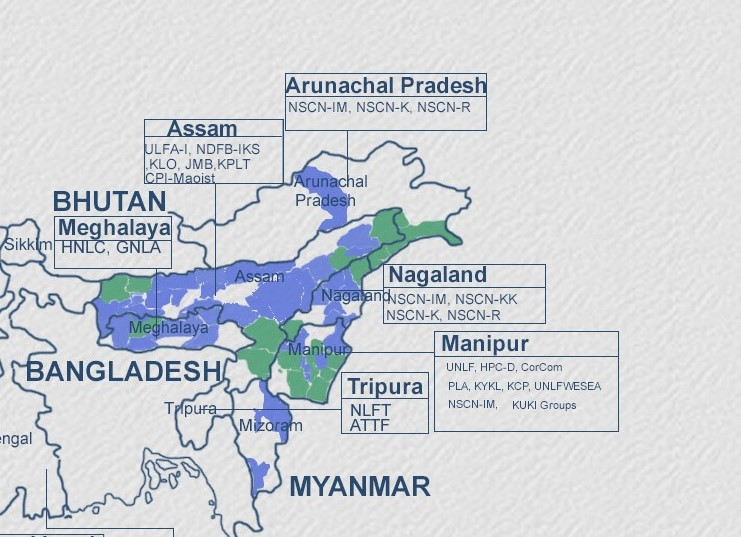Saloni Singh writes that the Northeast region of India has been grappling with insurgency for a considerable period of time, which has resulted in major obstacles to the growth and safety of the area. In the meantime, various governmental entities at both the central and state levels, as well as regional initiatives, have been established to confront the challenges imposed by the insurgency. The task of managing insurgency in Northeast India is intricate owing to a variety of factors.
Map-1[i]
Source: https://www.satp.org/conflict-maps/india
Roadblock to Peace:
The insurgency in Northeast India present formidable challenges due to diverse ethnicities and identities in the region. Reconciling intricate identity concerns with national unity is complicated by escalating tensions and autonomy-seeking factions. Geographical limitations, such as uneven terrain and porous borders, give tactical advantages to insurgent groups, hindering security forces’ efforts. The widespread availability of weapons[ii], manufactured domestically or illicitly imported, empowers non-state actors. Multiple armed factions often clash and dispute territory, further impeding peaceful resolutions. Providing assistance to rebel factions from neighbouring nations creates notable obstacles, requiring cooperation and intelligence sharing. Resolving the root causes of insurgency involves addressing deficient infrastructure, high unemployment rates, and sluggish socio-economic development. Addressing socio-economic disparities is crucial for achieving sustainable peace and stability in Northeast India.
Regional Initiatives: Working towards Peace and Development
Various regional initiatives have been implemented to address the insurgency in Northeast India.
Regional Organizations as Catalysts for Cooperation:
Regional organisations, like South Asian Association for Regional Cooperation (SAARC) and Bay of Bengal Initiative for Multi-Sectoral Technical and Economic Cooperation (BIMSTEC)[iii], are instrumental in promoting communication and collaboration among member nations. These platforms facilitate engagement, idea exchange, and collaborative efforts in countering insurgency. The effectiveness of these efforts is frequently impeded by political divergences, conflicting objectives, and restricted authority to make decisions, thus requiring improved coordination and dedication among participating countries.
Cross-Border Dynamics and Collaboration:
The insurgency in Northeast India has transnational roots[iv], making international cooperation all the more important. The India-Myanmar-Thailand Trilateral Highway[v] and the Bangladesh-India Border Haats[vi] are examples of initiatives that facilitate economic integration and connectivity, thereby creating a favourable environment for regional cooperation. Border disputes, porous borders, and divergent national interests present challenges to collaboration, requiring trust-building measures and joint border management mechanisms.
Intelligence Sharing and Joint Counter-Terrorism Efforts:
The Indian Ocean Rim Association (IORA) and the Indian Ocean Naval Symposium (IONS) offer prospects to improve maritime security[vii] and intelligence collaboration. Intelligence sharing encounters obstacles such as national security apprehensions, restricted trust, and the necessity to harmonise sovereignty with regional security priorities. Enhancing mechanisms to exchange intelligence in a timely and dependable manner is essential for effectively addressing insurgency.
Socioeconomic Development as a Counter-Insurgency Strategy:
Socioeconomic development is a crucial aspect of a comprehensive approach to addressing the fundamental root causes of insurgency. The Asian Development Bank (ADB) and the Mekong-Ganga Cooperation (MGC) prioritise inclusive growth, infrastructure development, and poverty reduction.[viii] These initiatives seek to alleviate the grievances that drive insurgency by investing in education, healthcare, and job creation. The effective resolution of the diverse challenges encountered by the Northeast Region (NER) can facilitate its successful integration with the Act East Policy.[ix] Overcoming resource constraints, implementation gaps, and unequal distribution of benefits is necessary to achieve sustainable development and long-term peace
Role of Civil Society and Track II Diplomacy:
The promotion of Track II diplomacy and engagement with civil society are crucial in combating insurgency.[x] NGOs, think tanks, and peacebuilding initiatives facilitate dialogue, reconciliation, and grassroots participation. Regional organisations can utilise these channels to enhance the representation of marginalised communities, facilitate conflict resolution, and establish comprehensive peace processes.
The efforts by regional organisations and initiatives aimed at addressing insurgency in Northeast India present significant prospects for cooperation, dialogue, and collaboration. Nevertheless, there are significant hurdles to overcome in achieving cooperation and collaboration among nations, including political differences, border disputes, limited trust, and resource constraints. So, it is necessary to have sustained commitment, improved coordination, and recognition of the interconnected nature of the issue. By prioritising intelligence sharing, socioeconomic development, and inclusive peacebuilding can pave the way for a peaceful and prosperous Northeast India, benefiting the entire region as a whole.
Author: Saloni Singh, Research Intern, CS3, USI
Endnotes
[i] “Conflict Map, India.”Map represent the Northeastern states of India with the major insurgent groups.
[ii] “Datasheet-Terrorist-Attack-Recovery-of-Arms.” Total arm recovery from the region in year 2000-2023 (Till June 10, 2023) is 20129
[iii] Jaman Shishir and Sakib, “How Interests and Ideas of a Dominant Actor Make a Big Difference: Analyzing India’s Role in SAARC and BIMSTEC – Chinese Political Science Review.”
[iv] Kumar, “Causes of Insurgency in North East India – The Geopolitics.”
[v] Briefing, “India–Myanmar–Thailand Trilateral Highway: An Investment Opportunity in the Making – India Briefing News.”
[vi] Ahmed, “Border Haats: A New Horizon of Revitalising Connectivity and Old Bonding between Citizens of Bangladesh and India | ORF.”
[vii] “Problems And Prospects of Maritime Security Cooperation in The Indian Ocean Region: A Case Study Of The Indian Ocean Naval Symposium (Ions) – Part I – National Maritime Foundation.”
[viii] “Infrastructure for Supporting Inclusive Growth and Poverty Reduction in Asia.”
[ix] “Integrating India’s North Eastern Region in the Backdrop of Act East Policy | Manohar Parrikar Institute for Defence Studies and Analyses.”
[x] “The Relationship between Track One and Track Two Diplomacy | Conciliation Resources.”



Very nice mam
Great Work, Saloni.
Great Work Saloni